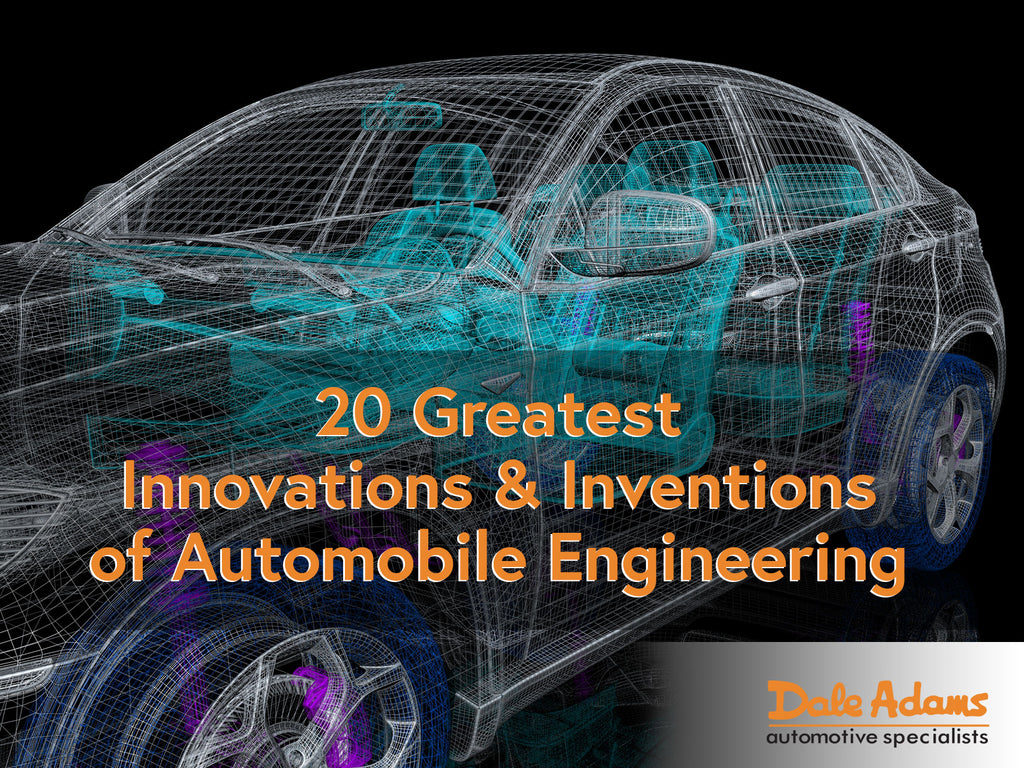20 Greatest Innovations & Inventions of Automobile Engineering from InterestingEngineering.com
20 Greatest Innovations & Inventions of Automobile Engineering
Automobiles have changed a lot since the 1990's, let alone the beginning of 20th Century. These 20 important innovations in automobile engineering are no exception.
They really help show us just how far the technology has come since the paradigm shift in the 20th Century. The following list is far from exhaustive and is in no particular order.
1. The Steam Engine Kicked Things Off
The steam engine was, undoubtedly, the most important innovation in automobile engineering. Although originally developed to pump water out of mines, improvements over time would drastically shrink the size of the technology.
The first reliable engine was developed by James Watt in 1775 but this was, in turn, refinement of the earlier Newcomen Engine.
Steam engines would initially lead to the development of locomotives and ship propulsion but would later be refined for use in early cars in the late 1800's to early 1900's. The steam car became popular at this time, especially as roads improved. Fuel was relatively cheap as well.
The fate of the steam engined car was sealed when Henry Ford fully developed his mass production process. Electrical starters for internal combustion engines also removed the need for hand crank engine starting but internal combustion engine driven cars would ultimately win out as they were much cheaper to buy.

2. The Internal Combustion Engine Made Cars 'Cheap'
The internal combustion engine is, by any standards, the de facto reason for the existence of the automobile, today. Although various examples of early engines have been around since the 1700's, it took Etienne Lenior to produce the first reliable one in 1859.
The modern internal combustion engine, as we know it, wouldn't be developed until Nikolaus Otto patented his atmospheric gas engine in 1864. Later developments were made by George Brayton (the first liquid fuel engine) and a collaboration with Otto, Daimler, and Maybach gave the world the first four-cycle engine in 1876.
The two-stroke engine was developed by Karl Benz a little later in 1879 with the production of Benz's first commercial motor vehicles commencing in 1886.

3. The Starter Engine Rendered Hand Cranks Obsolete
Internal combustion engines are feedback system that relies on inertia from each cycle to initiate the next. For this reason, cars need a way to rotate (crank) the engine so it can run on its own power.
Early engines used a variety of methods from gunpowder cylinders to springs to pure manpower using the iconic crank handle to do this. Although effective. these methods were inconvenient, sometimes difficult, and could be dangerous. Engines would often 'kick back' meaning the process was less than predictable.
What was needed was a less laborious, more convenient, and predictable means of starting the engine.
The first electric starter was developed in England by H. J. Dowsing in 1896. The first U.S. patent for one was in 1903 with an improved one in 1911. The first cars to have electrical starters installed were produced by Cadillac in 1912.
Starter motors have now come to dominate the automobile market but there rise was not guaranteed in the early 1900's with hand cranks still in use well into the 1920's. Interestingly hand cranks were still supplied by some manufacturers as late as the production of cars like the Citroen 2CV (1948-1990).
4. The Diesel Engine Is Pretty Efficient
The Diesel engine, or compression-ignition (CI Engine), was developed by Rudolf Diesel and is still today the highest thermal efficiency of any practical internal combustion engine. In some cases, low-speed diesel engines can have a thermal efficiency of just over 50%.
As the name suggests, ignition of the fuel is accomplished by mechanical compression of the air in the combustion chamber to such a degree that injected atomized diesel ignites instantaneously (adiabatic compression). This contrasts with spark ignition of petrol or gas engines.
Rudolf Diesel, after almost being killed by an earlier ammonia vapor fueled steam engine, decided to base his new engine on the Carnot Cycle instead. Soon after Karl Benz was awarded his patent in 1893, Diesel published his groundbreaking treatise "Theory and Construction of a Rational Heat-engine to Replace the Steam Engine and The Combustion Engines Known Today".
The Diesel engine was born.

5. Anti-lock Brakes Has Helped to Save Lives
Anti-lock brakes or anti-skid barking systems (ABS) are actually a pretty old piece of automobile engineering. Although modern systems were introduced in the 1950s in the Aero-industry and became popular in cars from the 1970s onwards, the concept dates from as early as 1908.
Modern systems allow the car to maintain tractive contact with the road during braking, thus preventing the wheels from locking or ceasing to rotate and therefore causing the vehicle to skid. The system is automated and takes advantage of the principles of threshold and cadence braking practiced by skilled drivers using the previous generation of braking systems.
The first patented 'ABS' was developed by German engineer Karl Wessel in 1928 - but he would never develop a working product. During the 1950's the technology began to take shape with Dunlop Maxaret's anti-skid system that was used extensively on UK jet aircraft like the Avro Vulcan and English Electric Lightning.
A truly modern system was introduced by Chrysler and was a computerized, three channel, four-sensor all-wheel ABS. It was called "Sure Brake" and came as standard on their 1971 Imperial. Other car manufacturers followed suit over the following decades with ABS being introduced in the 1990's on motorcycles.

6. Automatic Transmission Made Driving Easier
Automatic transmission, auto or self-shifting transmission as another great innovation in automobile engineering. The automated system frees the driver from the need to change gear ratios manually as the vehicle is on the move.
This innovation, in a pinch, immediately reduced the number of controls that a driver needs to use to control the automobile. It has had obvious advantages for individuals with disabilities but also means the driver can keep two hands on the wheel more often than in manual cars.
It was originally developed in 1921 by Alfred Horner Munro, a Canadian. He patented his design in 1923 and acquired UK and US patents in 1924 and 1927 respectively.
Munro was actually a steam engineer and his early design used compressed air rather than hydraulic fluid as used by modern systems. Sadly, he never found a commercial application. Two Brazilian engineers, José Braz Araripe and Fernando Lely Lemos, developed a hydraulic fluid version in 1932 and sold their design to General Motors in 1940.
The rest, as they say, is history.

7. Power Steering Made Driving More Pleasurable
Power Steering or power-assisted steering (PAS) is another great innovation in automobile engineering that helps drivers steer their cars. Using hydraulic or electric actuators, drivers need to exert much less effort when turning the steering wheel than in not PAS fitted vehicles, especially at low speeds or when stationary.
Early versions of power steering were patented in 1876, 1902 and 1904. but none of these made it into production. The first practical system was devised in 1926 by Francis W. Davis. He later moved to General Motors and further refined his designs.
Chrysler Corporation was the first to make power steering commercially available in a passenger car in their 1951 Imperial. GM quickly followed suit with their 1952 Cadillac.
Today, most vehicles come with power steering as standard.

8. Airbags: Saving Lives With the Power of Air
Airbags are one of the most important innovation in vehicle safety and automobile engineering. They are designed to inflate extremely quickly and deflate equally as fast during collisions, impacts or sudden rapid deceleration.
This technology has literally saved thousands of lives since their mass adoption in the automobile industry.
Airbags can trace their origin to air-filled bladders used as early as the 1950's. Their invention is widely credited to John W. Hetrick who registered his patent in 1951. A similar system was also patented in Germany by Walter Linderer at about the same time. Both systems used compressed air that was triggered using a spring, bumper contact or manually by the driver.
It would take the development of crash sensors in the 1960's for the technology to become widely adopted. Mercedes-Benz, GM, Ford, and Chrysler would include them in their cars from the 1970's but they wouldn't become standard until the 1990's.
9. Electric Car Engines Are a Thing of the Past and Future
Electric car engines have been around for much longer than you might expect. Although they have become 'mainstream' thanks to Tesla of late, the first practical production electric car appeared in London in 1884.
Another design, The Flocken Elektrowagen, was produced in Germany in 1888. They, along with steam car engines, also outsold the very first internal combustion engines, at least before the advent of the electric starter engine.
The early electrical cars were popular it the late 1800's and early 1900's as they offered a level of comfort and ease of use not achieved by rivaling technology at the time. It is estimated around 30,000 such vehicles had been produced by the turn of the 20th Century.
The internal combustion engine would ultimately win out, shunting electrical cars into the shadows until the electric cars renaissance in the late 20th Century.

10. GPS - U.S. Military Tech Getting You From A to B
GPS, or Global Positioning System, was originally developed by the United States Government for use by their armed forces. It was originally launched in 1973 and integrated various concepts from previous systems (including classified designs from the 1960s).
The first system used 24 satellites and became fully operational in 1995. Credit for its creation is often given to Roger L. Easton, Ivan A. Getting and Bradford Parkinson from various agencies.
Civilian use was allowed from as early as the 1980's. GPS systems have since become integrated into many modern technologies from your smartphone to your car and have revolutionized the way we all navigate.

11. Catalytic converter: Improving Air Quality Since the 1970's
The catalytic converter is one of the most important automobile engineering innovations of all time. Its ability to convert toxic and other pollutants into less-hazardous forms has improved the air quality of our cities drastically.
The basic concept is to pass exhaust gases through the converter, catalyzing it in a redox reaction. They have become a legal requirement on diesel and gasoline engines but can also be fitted to lean-burn engines and kerosene heaters and stoves.
They were first introduced in the U.S. to comply with the EPA's stricter regulations on exhaust emissions from 1975. Catalytic converters were the brainchild of Eugene Houdry, a French engineer, who'd moved to the U.S. in 1930.
He was shocked by the level of smog and pollution in Los Angeles when he arrived and decided to try to solve the problem. By the mid-1950's he filed for and was awarded, a patent for his technology.
It took stricter environmental regulations around the world for the mass adoption of them into cars. The first production converter, an improvement on Houdry's design, was produced in 1973.

12. Saving Lives with the Three-point Seat Belt
The now ubiquitous three-point seatbelt is designed to dissipate deceleration energy during a collision over the chest pelvis and shoulders of the passenger. It was first introduced by Volvo in 1959 and it was developed by Nils Bohlin who had previously worked for SAAB developing ejection seats.
Before this innovation, the two-point seat belt was the standard. these strapped across the body with a buckle placed over the abdomen. These were known to cause serious injuries during high-speed crashes.
This great innovation in automobile engineering first appeared in the Volvo PV 544 but became standard in the 1959 Volvo 122. Volvo would later make the patent open in the interest of safety for the general public and industry at large.
According to the U.S. National Highway Traffic Safety Administration that these beltS save around 11,000 lives every year.

13. Improved Fuel Efficiency with the Hybridized Drivetrain
When Toyota released the Prius in 1998, though production started in 1997, few would appreciate the impact it would have on the auto industry. It incorporated a hybrid drivetrain that dramatically improved fuel efficiency forcing other car manufacturers to follow suit.
The Prius was the first mass-produced hybrid that came with a tiny 1.5-liter gas engine, electric motor, and nickel-metal hydride battery. Although uptake was slow at first today most car brands have some form of hybrid vehicle in their catalog.

14. Stability Control Helped Stop Skids
ESC or Electronic stability control helps correct a skid if your car starts to slide. It is, in effect, an improvement on the anti-lock brake systems that preceded it. ESC had a marked improvement in car safety, especially during emergency situations.
As ESC yaw sensors detect a slide, the system applies the brakes on individual wheels to help correct the skid, and straighten the car. Some ESC systems also take control of the throttle to manage power to each wheel as well.
Mercedes-Benz and BMW brought ESC to their luxury market in the mid-1990s. As the technology improved over time it became a legal requirement in many countries in passenger cars from 2011.
15. Onboard diagnostics II (OBD II) Improved Engine Management
Onboard diagnostics II, OBD II for short, was the natural progression from the first onboard diagnostics systems from the 1980's.
Its introduction provided home mechanics and professional technicians a means of finding out what exactly is wrong with a vehicle through a series of codes.
OBD II also allowed for a considerably more sophisticated method of controlling the engine, improve fuel efficiency etc.
It was initially hated by car enthusiasts and mechanics it has sparked a new industry of scan tools and other aftermarket devices ranging from fuel economy meters to engine performance tuners.

16. Dual-Clutch Transmission Made Gear Shifts Seamless
Dual-Clutch Transmission (DCT) allows for a driver to switch between gears and enhanced and seamless speed compared to more traditional transmissions. It has resulted in a process that is as easy as an automatic transmission but quicker than a manual transmission.
On a typical six-speed DCT gearbox, one clutch will handle odd gears whilst the other will shifts even gears. Gear changes are controlled by a series of computers.
The concept was initially devised by a Frenchman, Adolphe Kegresse, before WW2, but he never made a working model.
DCT was first introduced in the 1980s in racing cars but was first brought to the general public by Volkswagen. Their first dual clutch transmission, DSG, was launched in 2003.
It has since become widely available in many other car brands from Lamborgini to Mercedes-Benz.

17. Smart Key (Fob): Effortless Engine Ignition
The traditional car key is fast becoming a living fossil in the auto industry. Smart keys are fast becoming the standard with many meaning engine ignition is started with the press of a button not the turning of a key.
Some even open the car you as you approach. These were once just a novelty with some early designs resembling a credit card.
As convenient as key fobs are, they could leave your car open to car hacking.

18. Turbochargers Increased Energy Power and Fuel Efficiency
Turbochargers, Turbos, have been used in production cars since the 1960's. They are effectively compressor that is driven by the cars exhaust gasses, forcing more air into the engine's cylinders.
More fuel and more air leads to more power and can make a smaller engine perform outside of its class. They are commonly used with Otto and Diesel cycle engines.
The technology was invented by Swiss Engineer Alfred Buchi who received a patent for it in 1905. They would initially find applications in aircraft engines, especially during WW2.
Today, car manufacturers now generally downsize their engine sizes to include turbocharged alternatives. This simultaneously boosts performance and increases fuel efficiency.

19. Flashing Turn Signals Lets Others Drivers Know Your Intentions
Another important automobile engineering innovation was the flashing turn signals (indicators). Early forms date as early as 1907 but the 1938 patented version is now widely offered, often legally required, on street legal cars.
They are required to blink on and off at a rate between 60 and 120 "blinks per minute". Older models used a thermal interrupter switch to provide the 'blink' but these have been replaced with transistor circuits.
But what about the clicking sound?
20. Cruise Control Paved the Way for Driverless Cars
Cruise control was first developed by one Ralph Teeter in the 1940's. He developed it in response to his belief that uneven speeds caused accidents.
And so Ralph succeeded in developing a servomechanism to help maintain a car's speed by taking control of the throttle from the driver. Although unpopular when first introduced in the 1950's it now comes as standard in many cars today.
The addition of radar to cruise control in the early 2000's has since taken the technology to the next level. It has also paved the way for driverless cars.

So there you go 20 of greatest innovations and inventions of Automobile Engineering. Have we missed any big ones?




Dale Adams
Author